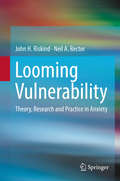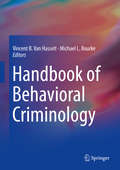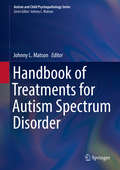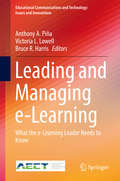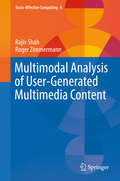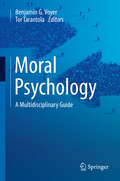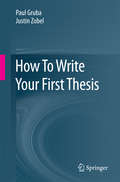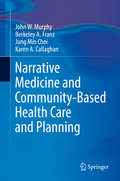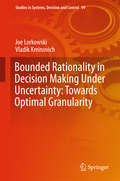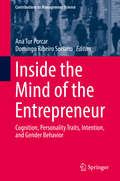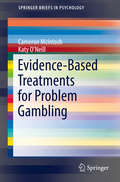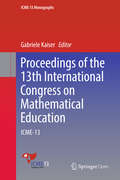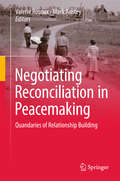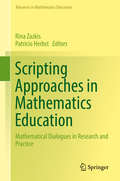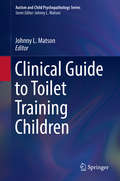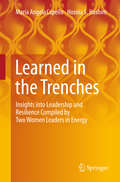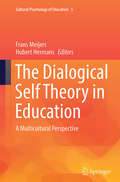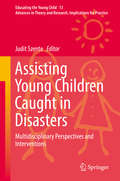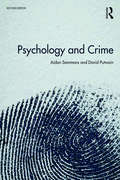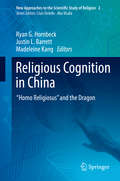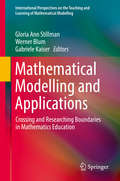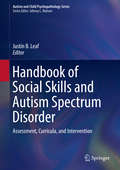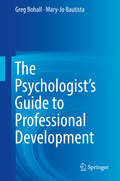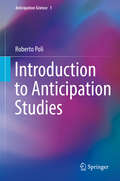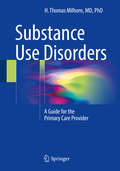- Table View
- List View
Looming Vulnerability: Theory, Research and Practice in Anxiety
by John H. Riskind Neil A. RectorThis stimulating resource presents the Looming Vulnerability Model, a nuanced take on the cognitive-behavioral conceptualization of anxiety, worry, and other responses to real or imagined threat. The core feature of the model—the perception of growing, rapidly approaching threat—is traced to humans’ evolutionary past, and this dysfunctional perception is described as it affects cognitive processing, executive functioning, emotions, physiology, and behavior. The LVM framework allows for more subtle understanding of mechanisms of and risk factors for the range of anxiety disorders as well as for more elusive subclinical forms of anxiety, worry, and fear. In addition, the authors ably demonstrate how the LVM can inform and refine cognitive-behavioral and other approaches to conceptualization, assessment, and treatment of these often disabling conditions. This important volume: · Introduces the Looming Vulnerability Model in its evolutionary, developmental, cognitive, and ecological contexts. · Unites diverse theoretical strands regarding anxiety, fear, and worry including work on wildlife behavior, experimental cognition and perception, neuroimaging, and emotion. · Defines the looming cognitive style as a core aspect of vulnerability. · Describes the measurement of the looming cognitive style, Looming Maladaptive Style Questionnaire, and measures of looming vulnerability for specific disorders. · Details diverse clinical applications of the LVM across the anxiety disorders. Spotlighting phenomena particularly relevant to current times, Looming Vulnerability, brings a wealth of important new ideas to researchers studying anxiety disorders and practitioners seeking more avenues for treating anxiety in their patients.
Handbook of Behavioral Criminology: Contemporary Issues And Strategies
by Vincent B. Van Hasselt Michael L. BourkeThis multidisciplinary volume assembles current findings on violent crime, behavioral, biological, and sociological perspectives on its causes, and effective methods of intervention and prevention. Noted experts across diverse fields apply a behavioral criminology lens to examine crimes committed by minors, extremely violent offenses, sexual offending, violence in families, violence in high-risk settings, and crimes of recent and emerging interest. The work of mental health practitioners and researchers is shown informing law enforcement response to crime in interrogation, investigative analysis, hostage negotiations, and other core strategies. In addition, chapters pay special attention to criminal activities that violate traditional geographic boundaries, from cyberstalking to sex trafficking to international terrorism.Among the topics in the Handbook:· Dyadic conceptualization, measurement, and analysis of family violence.· School bullying and cyberbullying: prevalence, characteristics, outcomes, and prevention.· A cultural and psychological perspective on mass murder.· Young people displaying problematic sexual behavior: the research and their words.· Child physical abuse and neglect.· Criminal interviewing and interrogation in serious crime investigations.· Violence in correctional settings.· Foundations of threat assessment and management. The Handbook of Behavioral Criminology is a meticulous resource for researchers in criminology, psychology, sociology, and related fields. It also informs developers of crime prevention programs and practitioners assessing and intervening with criminal clients and in correctional facilities.
Handbook of Treatments for Autism Spectrum Disorder (Autism and Child Psychopathology Series)
by Johnny L. MatsonThis handbook provides a comprehensive review of the numerous factors associated with treatments for children, youth, and adults with autism spectrum disorder (ASD). It offers in-depth analysis of evidence-based treatments for young children, providing coverage on interventions within social skills training, school curricula, communication and speech training, and augmentative communication. It also covers treatments for adolescents and adults, including vocational programs, social integration programs, and mental health resources. Chapters also review several popular interventions such as functional behavior analysis, sensory integration therapy, early intensive behavioral interventions (EIBI), and floor time. In addition, the Handbook discusses standards of practice, focusing on ethical issues, review boards, training concerns, and informed consent.Topics featured in the Handbook include:Training for parents of individuals diagnosed with ASD.Treatment of socially reinforced problem behavior.Comorbid challenging behaviors.Post-secondary education supports and programs for adults.The TEACCH Program for people with ASD.Treatment of addiction in adults with ASD.Diet and nutrition based treatments targeted at children with ASD. The Handbook of Treatments for Autism Spectrum Disorder is a must-have reference for researchers, clinicians/professionals, and graduate students in clinical child, school, and developmental psychology, child and adolescent psychiatry, and social work as well as rehabilitation medicine/therapy, behavioral therapy, pediatrics, and educational psychology.
Leading and Managing e-Learning: What the e-Learning Leader Needs to Know (Educational Communications and Technology: Issues and Innovations)
by Anthony A. Piña Victoria L. Lowell Bruce R. HarrisThis book provides state-of-the-art knowledge on how to establish, organize, staff, and develop online education/e-learning programs. It strengthens knowledge of the different technologies, infrastructure and issues necessary for leaders and managers to make competent decisions. It is the most comprehensive guide for administrative practice currently available for e-learning leaders and managers.
Multimodal Analysis of User-Generated Multimedia Content (Socio-Affective Computing #6)
by Rajiv Shah Roger ZimmermannThis book presents a summary of the multimodal analysis of user-generated multimedia content (UGC). Several multimedia systems and their proposed frameworks are also discussed. First, improved tag recommendation and ranking systems for social media photos, leveraging both content and contextual information, are presented. Next, we discuss the challenges in determining semantics and sentics information from UGC to obtain multimedia summaries. Subsequently, we present a personalized music video generation system for outdoor user-generated videos. Finally, we discuss approaches for multimodal lecture video segmentation techniques. This book also explores the extension of these multimedia system with the use of heterogeneous continuous streams.
Moral Psychology: A Multidisciplinary Guide
by Benjamin G. Voyer Tor TarantolaThis fascinating and timely volume explores current thinking on vital topics in moral psychology, spanning the diverse disciplines that contribute to the field. Academics from cognitive science, evolutionary biology, anthropology, philosophy, and political science address ongoing and emerging questions aimed at understanding the thought processes and behaviors that underlie our moral codes—and our transgressions. Cross-cutting themes speak to individual, interpersonal, and collective morality in such areas as the development of ethical behavior, responses to violations of rules, moral judgments in the larger discourse, and universal versus specific norms. This wide-angle perspective also highlights the implications of moral psychology research for policy and justice, with cogent viewpoints from: · Philosophy: empiricism and normative questions, moral relativism. · Evolutionary biology: theories of how altruism and moral behavior evolved. · Anthropology: common moral values seen in ethnographies from different countries. · Cognitive and neural sciences: computational models of moral systems and decision-making. · Political science: politics, governance, and moral values in the public sphere. · Advice on moral psychology research—and thoughts about its future—from prominent scholars. With the goal of providing a truly multidisciplinary forum for moral psychology, this volume is sure to spark conversations across disciplines and advance the field as a whole. Sampling the breadth and depth of an equally expansive and transformative field, Moral Psychology: A Multidisciplinary Guide will find an engaged audience among psychologists, philosophers, evolutionary biologists, anthropologists, political scientists, neuroscientists, lawyers, and policymakers, as well as a more general audience interested in better understanding the complexity of moral psychology research.
How To Write Your First Thesis
by Paul Gruba Justin ZobelMany courses and degrees require that students write a short thesis. This book guides students through their first experience of producing a thesis and undertaking original research. Written by experienced researchers and advisors, the book sets out signposts and tasks to help students to understand what is needed to succeed, including scoping a topic, managing references, interpreting data, and successful completion.For students, the task of writing a thesis is a transition from structured coursework to becoming a researcher. The book provides advice on:What to expect from research and how to work with a supervisorGetting organized and approaching the work in a productive wayDeveloping an overall thesis structure and avoidance of mistakes such as inadvertent plagiarismProducing each major component: a strong introduction, background chapters that are situated in the discipline, and an explanation of methods and results that are crucial to successful original researchHow to wrap up a complex project with an extended checklist of the many details needed to be checked before a final submissionProducing and managing a thesis for the first time can be a daunting task, and this reader-friendly guidebook provides a framework for students to do their best.
Narrative Medicine and Community-Based Health Care and Planning
by John W Murphy Berkeley A. Franz Jung Min Choi Karen A. CallaghanThis progressive resource brings the innovative power of narrative medicine to the forefront of community public health care. Chapters describe community involvement across a continuum of control, from health consultants describing problems and suggesting solutions to health committees designing programs and evaluating results. Narrative strategies to this end, including authentic dialogue and community mapping, are examined in the context of public health and fleshed out with examples of different levels of participation by community members. From the respectful collaboration modeled here, the principles of community public health care can potentially expand beyond the immediate community into other social domains on a greater scale. Included in the coverage:· Narratives, local knowledge, and world entry.· Community and narratives.· What is dialogue?· Storylines, causes, and locus of interventions.· Community mapping tells a story.· The politics of storytelling.Narrative Medicine and Community-Based Health Care and Planning gives health psychologists, sociologists, social workers, and public health administrators realistic practical insights for tapping into the unique resources communities and clients have to offer. This is the next step in the evolution of public health, toward large-scale improvements in care delivery, access to and relevance of services, and patient and community outcomes.
Bounded Rationality in Decision Making Under Uncertainty: Towards Optimal Granularity (Studies in Systems, Decision and Control #99)
by Joe Lorkowski Vladik KreinovichThis book addresses an intriguing question: are our decisions rational? It explains seemingly irrational human decision-making behavior by taking into account our limited ability to process information. It also shows with several examples that optimization under granularity restriction leads to observed human decision-making. Drawing on the Nobel-prize-winning studies by Kahneman and Tversky, researchers have found many examples of seemingly irrational decisions: e.g., we overestimate the probability of rare events. Our explanation is that since human abilities to process information are limited, we operate not with the exact values of relevant quantities, but with “granules” that contain these values. We show that optimization under such granularity indeed leads to observed human behavior. In particular, for the first time, we explain the mysterious empirical dependence of betting odds on actual probabilities. This book can be recommended to all students interested in human decision-making, to researchers whose work involves human decisions, and to practitioners who design and employ systems involving human decision-making —so that they can better utilize our ability to make decisions under uncertainty.
Inside the Mind of the Entrepreneur: Cognition, Personality Traits, Intention, and Gender Behavior (Contributions to Management Science)
by Ana Tur Porcar Domingo Ribeiro SorianoThis book connects entrepreneurship and psychology research by focusing on the personality dimensions of entrepreneurs, entrepreneurial cognition, entrepreneurial leadership, and gender behavior. It features state of the art interdisciplinary research offering a unified perspective on entrepreneurial psychology. Individual chapters address advances related to entrepreneurial intentions, complexity management, personality psychology, intrapreneurial behavior, entrepreneurial communities and demographic changes, among others. Laboratory experiments that study entrepreneurial behavior round out the coverage.
Evidence-Based Treatments for Problem Gambling (SpringerBriefs in Psychology)
by Cameron McIntosh Katy O'NeillThis international survey addresses gaps in the knowledge base on problem gambling, emphasizing evidence-based best practices for working with this diverse and notably resistant client population. A detailed introduction offers current findings on behavioral, affective, and neurological manifestations of disordered gambling, with prevalent types of resultant psychological, financial, and social harm. The book’s conceptual discussion examines clinical and sub-clinical presentations as well as the complex interplay of psychological and social factors that create barriers to seeking help. And on the practical side, up-to-date chapters detail widely-used and newer treatment options for compulsive gambling with the best chances of reducing treatment non-compliance and post-treatment relapses, including: · Psychoeducation.· Motivational interviewing.· Cognitive behavioral therapy.· Metacognitive and mindfulness approaches.· Acceptance and Commitment Therapy.· Dialectical Behavior Therapy.· Schema therapy.· Pharmacology.· Relapse Prevention. Evidence-Based Treatments for Problem Gambling is a ready source of insights, data, and strategies for counselors working in problem gambling treatment centers, and for psychologists and counselors operating in public or private practice who see individuals with problem gambling as a primary or comorbid presentation. Researchers, lecturers, and treatment clinic managers will find this presentation both informative and immediately useful.
Proceedings of the 13th International Congress on Mathematical Education: ICME-13 (ICME-13 Monographs)
by Gabriele KaiserThis book is open access under a CC BY 4.0 license. The book presents the Proceedings of the 13th International Congress on Mathematical Education (ICME-13) and is based on the presentations given at the 13th International Congress on Mathematical Education (ICME-13). ICME-13 took place from 24th- 31st July 2016 at the University of Hamburg in Hamburg (Germany). The congress was hosted by the Society of Didactics of Mathematics (Gesellschaft für Didaktik der Mathematik - GDM) and took place under the auspices of the International Commission on Mathematical Instruction (ICMI). ICME-13 brought together about 3.500 mathematics educators from 105 countries, additionally 250 teachers from German speaking countries met for specific activities. Directly before the congress activities were offered for 450 Early Career Researchers. The proceedings give a comprehensive overview on the current state-of-the-art of the discussions on mathematics education and display the breadth and deepness of current research on mathematical teaching-and-learning processes.The book introduces the major activities of ICME-13, namely articles from the four plenary lecturers and two plenary panels, articles from the five ICMI awardees, reports from six national presentations, three reports from the thematic afternoon devoted to specific features of ICME-13. Furthermore, the proceedings contain descriptions of the 54 Topic Study Groups, which formed the heart of the congress and reports from 29 Discussion Groups and 31 Workshops. The additional important activities of ICME-13, namely papers from the invited lecturers, will be presented in the second volume of the proceedings.
Negotiating Reconciliation in Peacemaking: Quandaries of Relationship Building
by Valerie Rosoux Mark AnsteyThis book offers a unique approach to reconciliation as a matter for negotiation, bringing together two bodies of theory in order to offer insights into resolving conflicts and achieving lasting peace. It argues that reconciliation should not be simply accepted as an ‘agreed-upon norm’ within peacemaking processes, but should receive serious attention from belligerents and peace-brokers seeking to end violent conflicts through negotiation.The book explores different meanings the term ‘reconciliation’ might hold for parties in conflict - the end of overt hostilities, a transformation in the quality of relations between warring groups, a vehicle of accountability and punishment of human rights abusers or the means through which they might somehow acquire amnesty, and as a means of atonement and to material reparation. It considers what gives energy to the idea of reconciliation in a conflict situation—why do belligerents become interested in settling their differences and changing their attitudes to one another? Using a range of case studies and thematic discussion, chapters in this book seek to tackle these tough questions from a multidisciplinary perspective. Contributions to the book reveal some of the complexities of national and international reconciliation projects, but particularly diverse understandings of reconciliation and how to achieve it. All conflicts reflect unique dynamics, aspirations and power realities. It is precisely because parties in conflict differ in expectations of reconciliation outcomes that its processes should be negotiated. This book is a valuable resource for both scholars and practitioners engaged in resolving conflicts and transforming fragmented relations in conflict and post-conflict situations.
Scripting Approaches in Mathematics Education: Mathematical Dialogues in Research and Practice (Advances in Mathematics Education)
by Rina Zazkis Patricio HerbstThis book shows how the practice of script writing can be used both as a pedagogical approach and as a research tool in mathematics education. It provides an opportunity for script-writers to articulate their mathematical arguments and/or their pedagogical approaches. It further provides researchers with a corpus of narratives that can be analyzed using a variety of theoretical perspectives.Various chapters argue for the use of dialogical method and highlight its benefits and special features. The chapters examine both “low tech” implementations as well as the use of a technological platform, LessonSketch. The chapters present results of and insights from several recent studies, which utilized scripting in mathematics education research and practice.
Clinical Guide to Toilet Training Children (Autism and Child Psychopathology Series)
by Johnny L. MatsonThis book offers a comprehensive overview of the universal issue of toilet training in children and explores issues that need to be considered by clinicians and other professionals. The book begins with a historical overview of the field, including origins and reviews of current practices. It discusses various toileting problems and their side effects, risk factors, normal developmental milestones in toileting, and theories of toileting. Chapters identify behavior problems (e.g., self-injury, noncompliance) as well as medical conditions (e.g., diabetes, constipation) that can affect continence, with proven strategies for addressing these challenges in toilet training children, including those with intellectual and developmental disabilities. The book concludes with a discussion of the strengths of current toilet training practices as well as suggestions for areas where continued improvement is required.Topics featured in this book include:· Complications and side effects associated with the lack of toileting skills.· Technology used in toilet training.· Applications of operant-based behavioral principles to toilet training.· Toilet training strategies involving modeling and modifications of the physical environment.· Toilet training children with physical disabilities. The Clinical Guide to Toilet Training Children is a must-have resource for researchers, graduate students, clinicians, and related therapists and professionals in clinical child and school psychology, pediatrics, family studies, developmental psychology, nursing, social work, and behavioral therapy/rehabilitation.
Learned in the Trenches: Insights into Leadership and Resilience Compiled by Two Women Leaders in Energy
by Maria Angela Capello Hosnia S. HashimThis book shares the learnings and perspectives of two pioneer women who waded the many challenges posed by multiculturalism and gender in one of the corporate environments more rigid and traditional in the business world: the energy sector in the Middle East.How they managed to create a growth space for themselves and their teams is a story of professional and personal tenacity, shaping a privileged perspective that enabled them to understand the root causes of barriers, as well as envision plausible solutions. They propose in the book not only their vision, but a remarkable collection of unfiltered interviews to influential leaders in the energy sector, to complete a vision of what is key to achieve success when leading or consulting in a corporate environment. The book offers a compilation of very personal approaches to professionalism, resilience, work, and ultimately, success, from within and outside the ranks of highly regarded corporations in the energy sector. The ultimate aim is that of triggering a self-reflection in the readers, grounded on the learnings and perspectives of those who made it to the highest roles of one of the less understood business environments.
The Dialogical Self Theory in Education: A Multicultural Perspective (Cultural Psychology of Education #5)
by Frans Meijers Hubert HermansThis edited volume offers cross-country and cross-cultural applications of Dialogical Self Theory within the field of education. It combines the work of internationally recognized authors to demonstrate how theoretical and practical innovations emerge at the highly fertile interface of external and internal dialogues. The Theory, developed by Hubert Hermans and his colleagues in the past 25 years, responds fruitfully to the issue of educational experts hitherto working in splendid isolation and does so by combining two aspects of Dialogical Self Theory: the dialogue among individuals as well as dialogical processes within individuals, in this context students and teachers. It is the first book in which Dialogical Self Theory is applied to the field of education. In 13 chapters, authors from different cultures and continents produce theoretical considerations and a wide variety of practical procedures showing that this interface is an ideal ground for the production of new theoretical, methodological, and practical approaches that enrich the work of educational researchers and specialists. Academics, practitioners, and postgraduate students in the field of education, particularly those who are interested in the innovative and community-enhancing potentials of dialogue, will find this book valuable and informative. Ultimately the work presented here is intended to inspire more self-reflection and creative ways to engage in new conversations that can respond to real-world issues and in which education can play a more vital role.
Assisting Young Children Caught in Disasters: Multidisciplinary Perspectives and Interventions (Educating the Young Child #13)
by Judit SzenteThis volume discusses 14 different types of disasters and their implications on the social, emotional and academic development of young children, from birth through age eight. It focuses on human-related crises and disasters such as community violence exposure; war and terrorism; life in military families; child trafficking; parent migration; radiation disasters; HIV/AIDS; and poverty. The environment-related disasters addressed in this book include hunger; hurricanes; earthquakes; frostbites; wildfires; and tornadoes. The volume includes suggestions for interventions, such as using picture books with young children in coping with natural disasters and human crises. In addition, each chapter provides research-based strategies for early childhood and related professionals to be used in the classroom. Many children in our world today experience some type of disasters and/or crises. These crises or disasters can either be human- or environment-related and can interrupt children’s daily lives. They often negatively impact children’s development, education, and safety. Bringing together authors representing a variety of countries including Australia, Canada, China, Finland, Haiti, Hungary, Kenya, USA, and Zimbabwe, this book provides truly global perspectives on the various types of disasters and their implications for our work with young children.
Psychology and Crime: 2nd edition
by Aidan Sammons David PutwainWhat does a criminological psychologist actually do? Most people picture a modern-day Sherlock Holmes, helping the police to solve crimes, but the reality is far more interesting and complex. Psychology and Crime offers a fascinating introduction to criminological psychology, providing the reader with a comprehensive grounding in everything from cognitive forensics to police interviewing. Concise, informative and accessible, the book explores a range of theories to understand criminal behaviour, from the physiological to the social. It covers a range of contexts within the criminal justice system where psychology offers unique insights, including police investigation, the perspective of witnesses and victims, and courtroom proceedings. Thoroughly updated throughout to reflect developments in the field, and featuring new chapters covering cybercrime, terrorism and insights from neuroscience, this edition also includes a student-friendly ‘Apply your learning’ feature and case studies to bring the research to life. Accessibly written for all levels, and with concise coverage of both classic and contemporary psychological theory, this is the ideal book for anyone studying criminal or forensic psychology.
Religious Cognition in China: “Homo Religiosus” and the Dragon (New Approaches to the Scientific Study of Religion #2)
by Ryan G. Hornbeck Justin L. Barrett Madeleine KangAre human tendencies toward religious and spiritual thoughts, feelings, and actions outcomes of “natural” cognition? This volume revisits the “naturalness theory of religious cognition” through discussion of new qualitative and quantitative studies examining the psychological foundations of religious and spiritual expression in historical and contemporary China. Naturalness theory has been challenged on the grounds that little of its supporting developmental and experimental research has drawn on participants from predominantly secular cultural environments. Given China’s official secularity, its large proportion of atheists, and its alleged long history of dominant, nonreligious philosophies, can any broad claim for religion’s psychological “naturalness” be plausible? Addressing this empirical gap, the studies discussed in this volume support core naturalness theory predictions for human reasoning about supernatural agency, intelligent design, the efficacy of rituals, and vitalistic causality. And yet each study elucidates, expands upon, or even challenges outright the logical assumptions of the naturalness theory. Written for a non-specialist audience, this volume introduces the naturalness theory and frames the significance of these new findings for students and scholars of cultural psychology, the psychology of religion, the anthropology of religion, and Chinese Studies.
Mathematical Modelling and Applications: Crossing and Researching Boundaries in Mathematics Education (International Perspectives on the Teaching and Learning of Mathematical Modelling)
by Gloria Ann Stillman Werner Blum Gabriele KaiserThis volume documents on-going research and theorising in the sub-field of mathematics education devoted to the teaching and learning of mathematical modelling and applications. Mathematical modelling provides a way of conceiving and resolving problems in the life world of people whether these range from the everyday individual numeracy level to sophisticated new problems for society at large. Mathematical modelling and real world applications are considered as having potential for multi-disciplinary work that involves knowledge from a variety of communities of practice such as those in different workplaces (e.g., those of educators, designers, construction engineers, museum curators) and in different fields of academic endeavour (e.g., history, archaeology, mathematics, economics). From an educational perspective, researching the development of competency in real world modelling involves research situated in crossing the boundaries between being a student engaged in modelling or mathematical application to real word tasks in the classroom, being a teacher of mathematical modelling (in or outside the classroom or bridging both), and being a modeller of the world outside the classroom. This is the focus of many of the authors of the chapters in this book. All authors of this volume are members of the International Community of Teachers of Mathematical Modelling (ICTMA), the peak research body into researching the teaching and learning of mathematical modelling at all levels of education from the early years to tertiary education as well as in the workplace.
Handbook of Social Skills and Autism Spectrum Disorder: Assessment, Curricula, and Intervention (Autism and Child Psychopathology Series)
by Justin B. LeafThis handbook identifies the various social deficiencies widely associated with children and youth diagnosed with autism spectrum disorder (ASD). It discusses possible causes as well as the lifelong effects if these deficiencies are not addressed. The handbook presents current behavioral and curriculum-based methods for assessing social deficits. Chapters examine the various interventions that have been used to improve social skills and behavior, including video modeling, peer-mediated interventions, and script fading. Chapters also assess various interventions using empirically based procedures, evaluate the research of each of these procedures, provide guidelines for treatment planning, and offer clinical recommendations. The handbook concludes with future directions for the development of both social behavior and clinical social skills interventions.Topics featured in the Handbook include:Impairments in social behavior that may result in negative outcomes such as depression, loneliness, and suicide in individuals with ASD.Bullying among youth with ASD.Behavioral skills training to promote social behavior of individuals with ASD.The Early Start Denver Model approach to helping young children with ASD.The implementation of social skills groups for individuals diagnosed with ASD.The Handbook of Social Skills and Autism Spectrum Disorder is a must-have resource for researchers, clinicians/professionals, and graduate students in clinical child, school, and developmental psychology, behavioral therapy, and social work, as well as such interrelated disciplines as child and adolescent psychiatry, rehabilitation medicine/therapy, pediatrics, and special education/educational psychology.
The Psychologist's Guide to Professional Development
by Greg Bohall Mary-Jo BautistaThis essential career guide equips new professionals and doctoral students with a robust foundation for a long and satisfying career in psychology and other behavioral health professions. Taking a proactive intervention prevention approach to career planning and building, contributors offer accessible guidelines and advice in core areas such as specialization and niche specialties, the market for services, cultural competence, ethically and legally sound practice, and personal competencies including self-care, the degree-to-career transition, and financial planning. The editors also break down the mental health field into discrete disciplines, each with its own trajectory for its future relevance and sustainability. By bringing this wide range of career information together, this book helps to set much-needed standards for professional development in a demanding, diversifying, and evolving field. Featured in the coverage: · The personal development foundation.· Professional relationships and the art of networking.· The clinical credentialing process.· Clinical, educational, and administrative supervision.· The curriculum vitae and professional marketing.· The early career professional advantage. The Psychologist’s Guide to Professional Development serves as an invaluable text for professional development courses in the fields of psychology, counseling, social work, marriage and family therapy, as well as a trusted mentor-between-covers for the long term.
Introduction to Anticipation Studies (Anticipation Science #1)
by Roberto PoliThis book presents the theory of anticipation, and establishes anticipation of the future as a legitimate topic of research. It examines anticipatory behavior, i.e. a behavior that ‘uses’ the future in its actual decisional process. The book shows that anticipation violates neither the ontological order of time nor causation. It explores the question of how different kinds of systems anticipate, and examines the risks and uses of such anticipatory practices. The book first summarizes the research on anticipation conducted within a range of different disciplines, and describes the connection between the anticipatory point of view and futures studies. Following that, its chapters on Wholes, Time and Emergence, make explicit the ontological framework within which anticipation finds its place. It then goes on to discuss Systems, Complexity, and the Modeling Relation, and provides the scientific background supporting anticipation. It restricts formal technicalities to one chapter, and presents those technicalities twice, in formal and plain words to advance understanding. The final chapter shows that all the threads presented in the previous chapters naturally converge toward what has come to be called “Discipline of Anticipation”
Substance Use Disorders: A Guide for the Primary Care Provider
by H. Thomas MilhornThis practical and timely book provides comprehensive, state-of-the-art guidance on how primary care clinicians can best care for patients with substance use disorders. The book covers the major drugs of abuse, as well as the more recent ones, detailing the biology of various addictions and all dimensions of clinical diagnosis and management. It is organized in four parts: (1) The Basics, (2) Psychoactive Substance Dependencies, (3) Diagnosis, Treatment, Recovery, Relapse, and the Family, and (4) Special Groups. Part I, The Basics, consists of an overview, the various definitions of substance dependence, and the pharmacology of addictive substances. Chapter 1, Overview, is an introductory chapter that covers material common to the entire field of substance dependence. Chapter 2 covers the various definitions of substance dependence, and Chapter 3 reviews the pharmacology of addictive substances. Part II, Psychoactive Substance Dependencies, explains the various drug dependencies—alcohol dependence, sedative-hypnotic dependence, opioid dependence, stimulant dependence, nicotine dependence, cannabis dependence, dissociative dependence, inhalant dependence, hallucinogen dependence, and anabolic steroid dependence. Part III addresses diagnosis, treatment, recovery, relapse, and the family. Part IV, Special Groups, discusses substance dependence in women, adolescents, the elderly, ethnic minority groups, co-occurring disorders, LGBT patients, HIV positive patients, and the impaired physician. In addition to primary care physicians, Substance Use Disorders: A Guide for the Primary Care Provider will serve as an invaluable resource to primary care nurse practitioners and physician assistants, as well as medical students, primary care residents, emergency medicine physicians, ASAM and APA certified addictionists and those studying for certification in those specialties, psychiatrists, psychologists, and alcohol/drug counselors.
